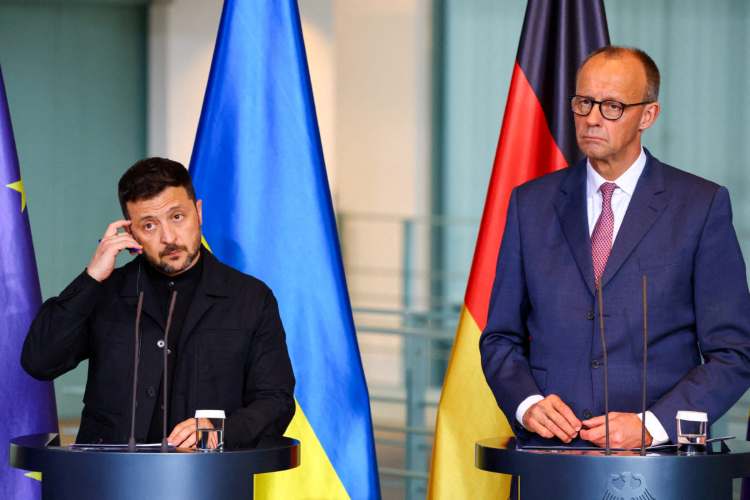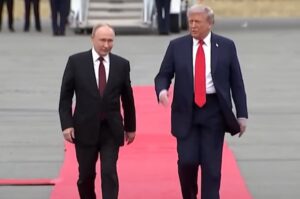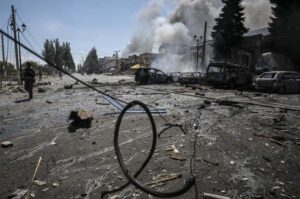
Elusive Ukraine peace: The much-watched meeting between US President Donald Trump and Russia’s Vladimir Putin ended with warm words but no ceasefire. The optics were extraordinary — a literal red carpet, a smiling photo op, even a shared ride in the presidential limousine — yet the substance did not budge. Both leaders said they had made progress, but none would say on what. The impasse points to the underlying problem: Ukraine peace will not be possible while Europe keeps escalating military transfers to Ukraine and to states on Russia’s borders.
A strategy built around ever more weapons has entrenched Moscow’s sense of siege, narrowed space for compromise, and lengthened the war’s shadow over Europe.
The summit confirmed that diplomatic theatre cannot substitute for changes in the military balance. Trump arrived seeking an immediate ceasefire but stepped back from that demand by nightfall, while Putin departed with symbolism rather than concessions. Europe should read that tableau clearly. As long as the battlefield logic rewards attrition, even high-profile summits will yield atmospherics, not agreement.
READ I Private investment in uranium mining and India’s energy future
Europe’s rearmament and Ukraine peace
Since 2022, European states have embarked on the fastest rearmament since the Cold War. NATO’s new pledges raise defence investment well beyond the old two per cent norm, with a pathway to much higher outlays. Poland already spends close to five percent of GDP and the Baltic states are well above three. Meanwhile, the European Union has channelled windfall profits from frozen Russian assets and the European Peace Facility into sustained military support for Kyiv. The intent — deterrence — is understandable; the effect has been to convince Moscow that time and escalation can still yield leverage.

The shift in European policy from defensive aid to enabling deep strike options has sharpened the security dilemma. Berlin has lifted restrictions on using Western supplied missiles to hit targets inside Russia and is exploring support for Ukraine’s own long-range programmes. For Moscow, these steps confirm a narrative of encirclement and proxy war. Deterrence theory holds that more capability should buy more stability; in practice, reciprocal escalation has narrowed room for compromise and lasting Ukraine peace.

While strategy hardens, the costs keep rising. The World Bank, European Commission and the United Nations estimate Ukraine’s recovery needs at roughly $524 billion over the next decade. Millions remain displaced inside the country and as refugees abroad. Each month of fighting destroys more infrastructure and pushes reconstruction further out of reach. Ukraine peace that merely freezes lines without lowering the temperature of the broader confrontation would be a pause, not a settlement.
Europe needs to recalibrate strategy
Europe needs to back off aggressive arming is not abandonment. It is a shift from open ended military maximalism to a framework that reduces incentives for further escalation while upholding Ukrainian sovereignty. Europe’s own security depends on preventing a forever war on its doorstep. That requires coupling credible, time bound military assistance with diplomatic off ramps and security guarantees that take Russia’s concerns seriously without conceding Ukraine’s independence.
First, announce a moratorium — time limited and reviewable — on transfers of new long range strike systems to Ukraine and to neighbouring states, paired with a verifiable ban on using existing Western supplied platforms to hit targets deep in Russia. Second, convene a pan European security dialogue under OSCE auspices to design mutual force posture constraints along NATO’s eastern flank and to codify incident prevention measures in the Baltic and Black Sea theatres.
Third, decouple reconstruction finance from escalation by front loading civilian aid and energy grid support while conditioning any additional lethal assistance on measurable de escalatory steps. Fourth, begin structured talks on a neutrality plus model for Ukraine—sovereign, armed for self-defence, protected by multilateral security guarantees, but not a launchpad for deep strike threats. None of this rewards aggression; it recognises that durable peace in Europe will require reducing the temperature on both sides of the front lines.
